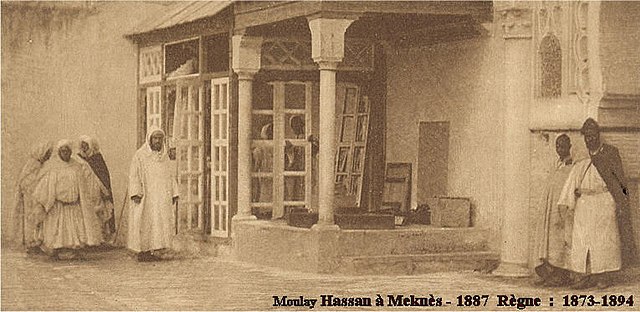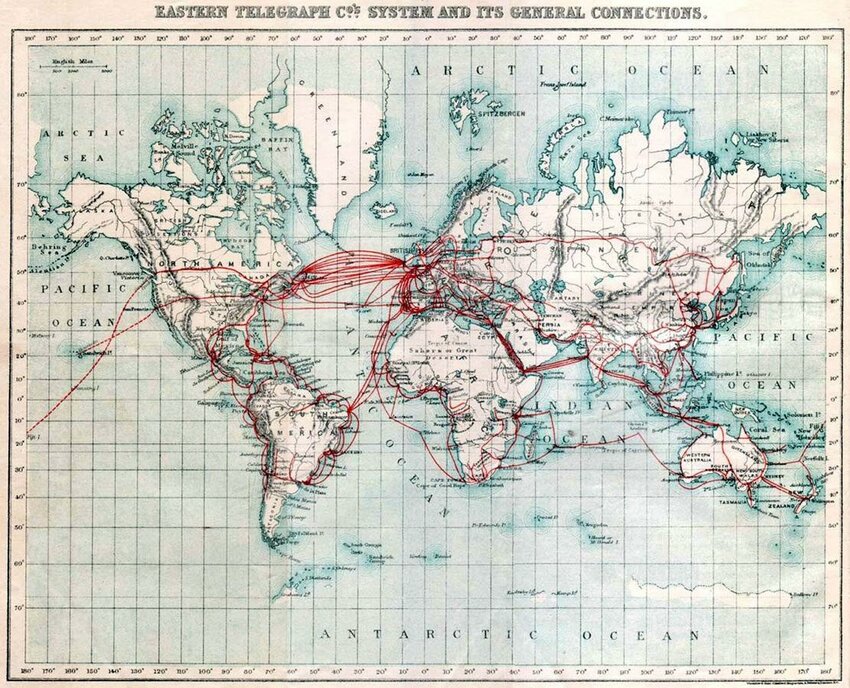The initial telegraph connection linking Morocco with Europe was established by the British. This underwater cable, laid across the sea from Gibraltar to Tangier during the 1880s, came after extensive efforts in lobbying and discussions between the British government and the Moroccan authorities known as the Makhzen. These talks highlight significant instances of European interference within the country and showcase Morocco's ongoing battle against external pressures and endeavors to safeguard its autonomy.
During the late 1880s, the Eastern Telegraph Company, a British firm focused on installing and managing submarine telegraph cables linking Britain with its overseas territories, took up the task of establishing communication between Gibraltar—a territory under British rule since 1704—and Tangier. This initiative aimed at streamlining the swift exchange of data between Europe and Morocco.
Even though the submarine cable marked the initial telegraphic link between Europe and Morocco, it represented the continent’s third European-African connection. Despite its importance, this pioneering initiative faced reluctance and resistance from Moroccan authorities.
The demand for a telegraph link arose in the 1870s when Makhzen authorities in Morocco realized the speed at which the telegraph could transmit information during talks with Spain regarding the restitution of Tetouan, as noted by Moroccan historian Khalid Ben Sghir in his work. Britain and Morocco During the Mission of John Drummond Hay, 1845-1886 .
Moroccan hesitation
As a result, came the initial plea to Sultan Moulay Hassan bin Mohammed, who ruled during this period under the name Hassan I. In 1873, John Hay Drummond Hay, Britain’s Envoy Extraordinary to the Moroccan court, made the pioneering request to the Sultan for authorization to build "an underwater telegraph line connecting Tangier with Gibraltar."
Nevertheless, Spain responded with a comparable demand for authorization to build an overland line connecting Tangier and Ceuta. This proposal reignited the Sultan’s concerns because he mentioned "the consequences of establishing a telegraph line through the lands of the Anjra tribe," which had only recently been engaged in conflict with Spain.
The Makhzen's rejection prompted the foreign delegates in Tangier to collectively decide against requesting the Sultan to build a land-based telegraph line. Instead, they proposed constructing an underwater telegraph from Tangier to Gibraltar, with the final decision regarding the route of the cables left entirely to the Sultan.

Following this, a highly persuasive appeal from Britain came next. Presented by Drummond Hay, the proposition was quite appealing as it informed the Sultan that the telegraph had already been adopted for use by various entities including the Ottomans, Egyptians, Tunisians, Indians, and Chinese.
Drummond Hay expressed curiosity in his plea about why "Morocco might wish to stay an exception," enumerating potential advantages it could derive from this kind of development. He mentioned these perks would encompass "swift communication with European capitals, nations within the Arab East, and notably during challenging times, with the British government."
Nevertheless, certain points highlighted by the British diplomat caused concern for the Sultan, particularly the notion that "Moroccan traders and all foreign merchants will... have access to current information regarding fluctuations in commodity prices for both imports and exports..."
This is what Sultan feared," noted Ben Sghir, "as the telegraph would serve as another tool in the hands of foreign traders and emissaries from foreign nations.
A telegraph cable however with certain conditions
The Sultan declined Drummond Hay’s plea, leading him to pursue a more assertive strategy. In 1875, under instructions from the British government, the British envoy secured a meeting with the Sultan where he showcased a telegraphic apparatus for Mawlay Hassan. As stated in Ben Sghir's work, "the Sultan expressed great pleasure at this invention and initially approved the idea of establishing a telegraph line connecting Tangier and Gibraltar."
Nevertheless, this accord was subject to certain stipulations as outlined by the Sultan in four key aspects: The structure must span across water rather than land; it ought to connect specifically to Tangier without extending elsewhere; the Makhzen would decide its precise location; and consensus among the diplomatic community for building the telegraph line under these terms had to be achieved.

The terms set forth by the Sultan were declined by the British firms participating in the initiative, which put the talks concerning the Tangier-Gibraltar cable on hold until 1884. As the year 1884 came to an end, the Eastern Telegraph Company finally consented to the Moroccan stipulations, paving the way for renewed discussions with the Makhzen authorities. Nonetheless, it was now the Sultan who withheld approval from the venture, demanding assurances from envoys of various foreign nations that these entities still supported the agreements established back in 1875.
In a letter, the Sultan reaffirmed his steadfast demand for adherence to his previous stipulations regarding the British cable. "The envoys must concur that it should run between Tangier and Gibraltar and nowhere beyond," penned Mawlay Hassan. "Despite their disagreement with this, even if every last one of them consents, such consent won’t stop them from putting forth comparable demands."
The request mentioned by the Sultan in his correspondence involved a Spanish telegraph cable connecting Tangier with Tarifa. According to Ben Sghir, the Makhzen declined to permit any construction of telegraph lines throughout its territories until every member of the diplomatic corps based in Tangier had agreed to accept the terms set out in 1875, without exception.
A malicious move
Nonetheless, this protocol was consistently disregarded, particularly by the individual who succeeded Drummond Hay. In November 1886, Kirby Green, the newly appointed British representative in Tangier, notified the British Foreign Office that the silence from the Moroccan Makhzen should not be interpreted as their approval of the initiative; quite the contrary, it did not signify their consent.
The Eastern Telegraph Company was subsequently directed to commence the installation of the cable. In a spiteful move, Green dispatched a memo to the Makhzen asserting that all requisite formalities for authorizing the telegraph line had been finalized by his predecessor, Drummond Hay.
Soon after, the Eastern Telegraph Company finished the project, and the telegraph cable linking Tangier with Gibraltar went live on January 20, 1887, without the Moroccan Sultan’s knowledge.
The situation intensified after Mawlay al-Hassan became aware of the British action, instructing his representative, Muhammad ibn al-'Arabi at-Torres, to halt the deployment. However, when these instructions were unsuccessful, the Sultan issued further commands aimed at convincing Green to withdraw from the initiative, hoping to prevent similar actions by other nations. Nevertheless, Green challenged the Sultan’s authority by presenting him with an accomplished fact, disregarding numerous communications and Moroccan objections which deemed the operation "unlawful."

In April 1887, when visiting Sultan Hassan I, Green was instructed to dismantle the British telegraph cable that had been laid across Moroccan soil without authorization from the Makhzen and against his approval. However, these instructions were disregarded by Green.
In 1889, the situation escalated when the Sultan dispatched a missive to the Qaid of Tangier, Mehdi al-Jirari, advising him to remain watchful regarding the activities of the British diplomat.
"Please inform His Excellency that we have learned about a British steamer arriving at the port of Tangier with a telegraph cable intended for connection with the existing cable in Tangier, followed by maritime linkage to the other ports of our illustrious kingdom," the Sultan penned.
Stay alert regarding this issue and make it your highest priority. Investigate what is occurring to ensure you do not become another victim of the troubles faced by former governors of Tangier due to the sudden installation of the telegraph against the desires of the Makhzen.
Even though the telegraph cable referenced by the Sultan in his correspondence was solely for upkeep, underlying concerns lay hidden beneath his apprehension and rage towards the British actions. To guarantee the repair of their own telegraph lines, the British dispatched warships to Tangier. Through intimidation tactics, Green succeeded in obtaining consent from Al-Tarris for the necessary repairs. According to Ben Sghir’s account, these repairs concluded early in April without resistance from the Makhzen, although they had little choice but to permit certain Moroccans to participate in the process.
Although Green interpreted the Sultan’s denial to permit the laying of the telegraph cable along with his reluctance as an act of isolationism, Ben Sghir clarifies that this perception was inaccurate. "The situation did not signify a rejection of advancement nor a path towards seclusion; rather, it represented a resistance against allowing foreign nations the ability to interfere and exert influence over Morocco, thus compromising its autonomy," the historian elucidates.
The Sultan's concerns turned out to be well-founded, even following his demise. Indeed, the very telegraph line he dreaded was eventually utilized to serve British objectives posthumously. As Javier Márquez Quevedo pointed out, "In 1894, the passing of the Sultan might have been concealed for roughly thirty-six hours—ample time for London to secure its interests." Telecommunication Networks and Imperial Competition: European Undersea Cable Connections to the Canary Islands and Northwestern Africa from 1883 to 1914 , to which France strongly objected.


0 Comments